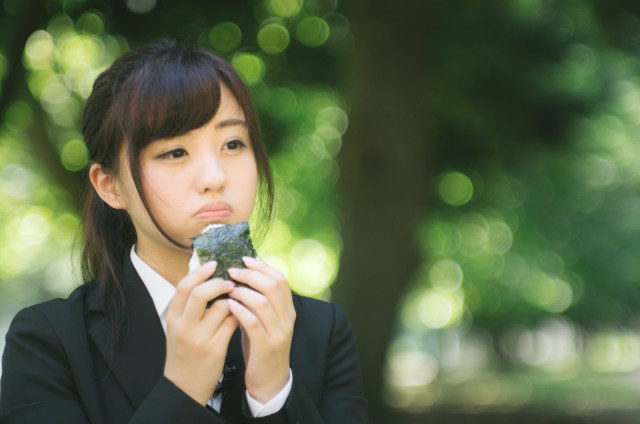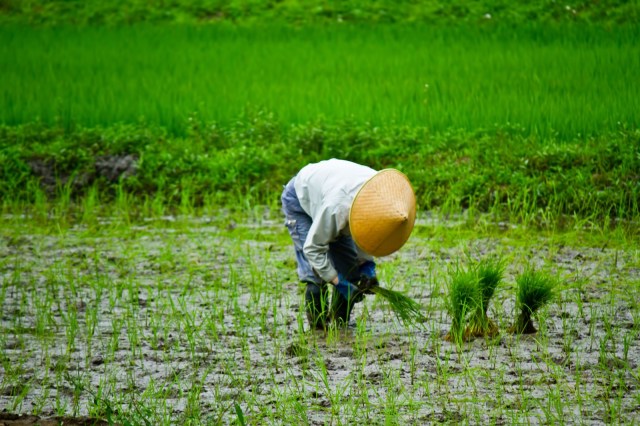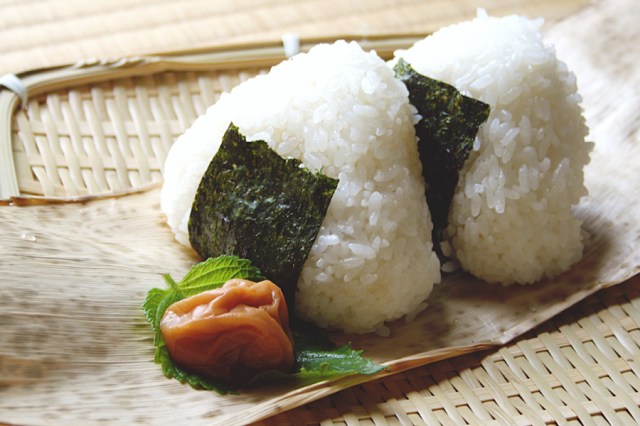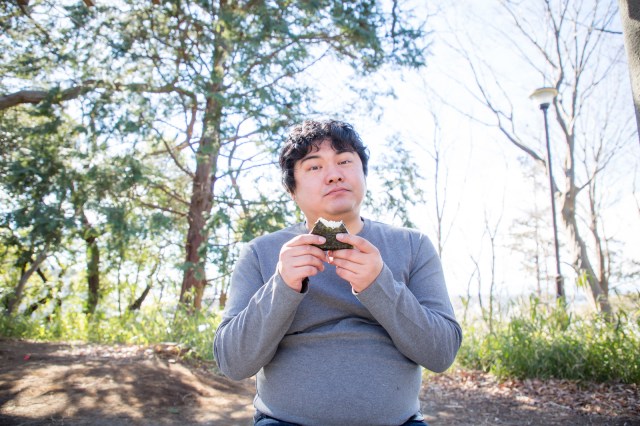
Even the humble onigiri isn’t safe from the complexities of Japanese etiquette.
With rules regarding chopstick use and taboos dictating the order in which dishes should be eaten, the world of Japanese food can be a confusing one to navigate, not just for foreigners but locals as well.
Now, a new morsel of eating etiquette has appeared on the culinary landscape, with a recent revelation made by Michiko Honda, Vice-Principal of “Infinity Finishing Academy” in Fukuoka City. She’s made waves online for pointing out the proper way to eat onigiri rice balls, and now people around the country aren’t sure what’s right or wrong anymore.
According to Honda, the best way to understand the importance of the rice ball is to first understand the importance of rice itself in Japanese culture. Not only is it an important food staple in Japan, rice cultivation has been credited with helping people form permanent settlements in ancient times, increasing the population and encouraging a group-centred way of life due to its production and related harvest festivals.
▼ Planting and harvesting large fields of rice is too big a job for one person to take on.
Prayers to the gods for ideal weather conditions led to rituals which are still performed today, even influencing ceremonies seen in traditional performing arts and sports like sumo. Major turning points in life also include rituals where rice is indispensable, like ubutatemeshi, a thanksgiving rice made for the gods after safe childbirth, and okuizome, the ceremonial first meal made for a baby on their 100th day of life.
So much of Japanese culture can be traced back to the importance of the grain, and rice balls themselves have a long and interesting history that deserves a mention. In the Nara Period (710-794), before the use of chopsticks became common, rice was often shaped into small balls so they could be picked up easily. Then in the Heian Period (794-1185), rice was shaped into small oval shapes and known as tonjiki.
The word “onigiri” came into use in the Edo Period (1603-1868), when these rice balls became triangular in shape and were widely popularised as a food that could travel well, allowing people to enjoy them on journeys, at hanami cherry blossom viewing picnics, and while watching plays.
Rice balls as we know them today are commonly purchased from supermarkets and convenience stores, but nothing beats the fresh taste of a homemade onigiri. Making a perfect triangle requires firm but gentle pressure from the palms of both hands, and it’s often said that thinking fond thoughts of the one you’re making the rice ball for is an act of love that will help it taste even more delicious. Honda points out that the word for palm, “tanagokoro“, means “te no kokoro” (“the hand’s heart”), which connects it to deeper meanings of love.
So, now that we’ve learnt about the history of onigiri and the importance of rice in daily life, what’s the right way to eat a rice ball? Well, according to Honda, the first thing people should be careful of is concealing the bitten part of the onigiri. Honda says the bitten portion is unsightly for others to see, so after taking a bite you should either keep the onigiri horizontal to your mouth as you eat it or split it in two before taking a bite, as this will make it easier to eat.
▼ Onigiri etiquette lesson: failed
The second point to remember is that you shouldn’t let the grains of rice stick to your hands in public. If this happens, licking the grains of rice off your fingers might seem like the most unwasteful option, but this doesn’t make a good impression on anyone, even if you tilt your head to try to hide what you’re doing. So use a hand towel to remove the rice grains instead.
One last thing to remember is that, as a general rule, if onigiri rice balls are included in bento boxes, they should be eaten with chopsticks and not with your hands.
With most people in Japan eating onigiri without any regard to etiquette, these three manner points immediately sparked debate online.
“What? It’s going to look a lot worse if the rice ball breaks and falls when you’re trying to halve it.”
“Onigiri is eaten by hand – it’s not designed to be elegant.”
“Next we’ll be told that all rice balls should be eaten with chopsticks instead of hands!”
“Isn’t it still too big to eat in one bite if you halve it?”
“Maybe they should just make rice balls bite-sized to avoid all this confusion.”
This pushback against onigiri etiquette is largely tied to the casual nature of the rice ball, which is commonly eaten in laid-back, relaxed situations. However, as an etiquette coach, Honda is always thinking of ways to add elegance and refinement to even the most casual situations.
She believes it’s good manners to show respect to the rice ball, and the rice within it, by acknowledging the hard work of farmers and communities involved in its production. And given that there are said to be seven gods in every grain of rice, it’s not a bad thing to consider.
Still, people in Japan are more than happy to leave manners by the wayside when it comes to eating rice balls. Because there’s already enough to keep in mind when it comes to food etiquette in Japan.
Source: Nishinippon Shimbun via Hachima Kikou
Top image: Pakutaso
Insert images: Gahag, Pakutaso (1, 2)
● Want to hear about SoraNews24’s latest articles as soon as they’re published? Follow us on Facebook and Twitter!




 Should you warm up your convenience store onigiri rice balls in the microwave?【Taste test】
Should you warm up your convenience store onigiri rice balls in the microwave?【Taste test】 The Big Bomb Onigiri Japanese rice ball helps us conquer mountain race but conquers us in the end
The Big Bomb Onigiri Japanese rice ball helps us conquer mountain race but conquers us in the end The surprising semi-secret ingredient in many Japanese convenience store rice balls: oil
The surprising semi-secret ingredient in many Japanese convenience store rice balls: oil In celebration of Onigiri Day, we compare rice balls from three different convenience stores
In celebration of Onigiri Day, we compare rice balls from three different convenience stores Bizarre or brilliant? Takoyaki and okonomiyaki rice balls available in convenience stores now
Bizarre or brilliant? Takoyaki and okonomiyaki rice balls available in convenience stores now Foreigner’s request for help in Tokyo makes us sad for the state of society
Foreigner’s request for help in Tokyo makes us sad for the state of society Ghibli Park now selling “Grilled Frogs” from food cart in Valley of Witches
Ghibli Park now selling “Grilled Frogs” from food cart in Valley of Witches Harajuku Station’s beautiful old wooden building is set to return, with a new complex around it
Harajuku Station’s beautiful old wooden building is set to return, with a new complex around it Smash Bros. director Sakurai stabs Kirby in the face, has delicious justification for it
Smash Bros. director Sakurai stabs Kirby in the face, has delicious justification for it Red light district sushi restaurant in Tokyo shows us just how wrong we were about it
Red light district sushi restaurant in Tokyo shows us just how wrong we were about it Osaka governor suggests lowering voting age to 0 to curb population decline
Osaka governor suggests lowering voting age to 0 to curb population decline Historical figures get manga makeovers from artists of Spy x Family, My Hero Academia and more
Historical figures get manga makeovers from artists of Spy x Family, My Hero Academia and more Suntory x Super Mario collaboration creates a clever way to transform into Mario【Videos】
Suntory x Super Mario collaboration creates a clever way to transform into Mario【Videos】 The five least stressful jobs, as ranked by Japanese working people
The five least stressful jobs, as ranked by Japanese working people Japanese politician’s birthrate plan: Have parents nag their kids to have “at least three babies”
Japanese politician’s birthrate plan: Have parents nag their kids to have “at least three babies” McDonald’s new Happy Meals offer up cute and practical Sanrio lifestyle goods
McDonald’s new Happy Meals offer up cute and practical Sanrio lifestyle goods Japanese ramen restaurants under pressure from new yen banknotes
Japanese ramen restaurants under pressure from new yen banknotes French Fries Bread in Tokyo’s Shibuya becomes a hit on social media
French Fries Bread in Tokyo’s Shibuya becomes a hit on social media Studio Ghibli releases new action figures featuring Nausicaä of the Valley of the Wind characters
Studio Ghibli releases new action figures featuring Nausicaä of the Valley of the Wind characters New private rooms on Tokaido Shinkansen change the way we travel from Tokyo to Kyoto
New private rooms on Tokaido Shinkansen change the way we travel from Tokyo to Kyoto Tokyo Tsukiji fish market site to be redeveloped with 50,000-seat stadium, hotel, shopping center
Tokyo Tsukiji fish market site to be redeveloped with 50,000-seat stadium, hotel, shopping center All-you-can-drink Starbucks and amazing views part of Tokyo’s new 170 meter-high sky lounge
All-you-can-drink Starbucks and amazing views part of Tokyo’s new 170 meter-high sky lounge Beautiful Ghibli sealing wax kits let you create accessories and elegant letter decorations【Pics】
Beautiful Ghibli sealing wax kits let you create accessories and elegant letter decorations【Pics】 Studio Ghibli releases Kiki’s Delivery Service chocolate cake pouches in Japan
Studio Ghibli releases Kiki’s Delivery Service chocolate cake pouches in Japan New definition of “Japanese whiskey” goes into effect to prevent fakes from fooling overseas buyers
New definition of “Japanese whiskey” goes into effect to prevent fakes from fooling overseas buyers Our Japanese reporter visits Costco in the U.S., finds super American and very Japanese things
Our Japanese reporter visits Costco in the U.S., finds super American and very Japanese things Studio Ghibli unveils Mother’s Day gift set that captures the love in My Neighbour Totoro
Studio Ghibli unveils Mother’s Day gift set that captures the love in My Neighbour Totoro More foreign tourists than ever before in history visited Japan last month
More foreign tourists than ever before in history visited Japan last month New Pokémon cakes let you eat your way through Pikachu and all the Eevee evolutions
New Pokémon cakes let you eat your way through Pikachu and all the Eevee evolutions Sales of Japan’s most convenient train ticket/shopping payment cards suspended indefinitely
Sales of Japan’s most convenient train ticket/shopping payment cards suspended indefinitely Sold-out Studio Ghibli desktop humidifiers are back so Totoro can help you through the dry season
Sold-out Studio Ghibli desktop humidifiers are back so Totoro can help you through the dry season Japanese government to make first change to romanization spelling rules since the 1950s
Japanese government to make first change to romanization spelling rules since the 1950s Ghibli founders Toshio Suzuki and Hayao Miyazaki contribute to Japanese whisky Totoro label design
Ghibli founders Toshio Suzuki and Hayao Miyazaki contribute to Japanese whisky Totoro label design Doraemon found buried at sea as scene from 1993 anime becomes real life【Photos】
Doraemon found buried at sea as scene from 1993 anime becomes real life【Photos】 Tokyo’s most famous Starbucks is closed
Tokyo’s most famous Starbucks is closed One Piece characters’ nationalities revealed, but fans have mixed opinions
One Piece characters’ nationalities revealed, but fans have mixed opinions We asked a Uniqlo employee what four things we should buy and their suggestions didn’t disappoint
We asked a Uniqlo employee what four things we should buy and their suggestions didn’t disappoint Princesses, fruits, and blacksmiths: Study reveals the 30 most unusual family names in Japan
Princesses, fruits, and blacksmiths: Study reveals the 30 most unusual family names in Japan Okinawan soul fool Pork Tamago Onigiri sold not at a five-star restaurant, but at an airport
Okinawan soul fool Pork Tamago Onigiri sold not at a five-star restaurant, but at an airport Less than half of Japanese people OK with bare hand-pressed rice balls, survey says, but why?
Less than half of Japanese people OK with bare hand-pressed rice balls, survey says, but why? Onikun: Epic onigiri so big they’re half demon, half rice ball
Onikun: Epic onigiri so big they’re half demon, half rice ball Onigiri jewellery from Japan lets you wear your love of Japanese food on your fingers
Onigiri jewellery from Japan lets you wear your love of Japanese food on your fingers Awesome rice ball making machine promises perfectly pressed onigiri in just 30 seconds【Video】
Awesome rice ball making machine promises perfectly pressed onigiri in just 30 seconds【Video】 Is it OK to put other food on top of your white rice when eating in Japan?
Is it OK to put other food on top of your white rice when eating in Japan? Which Japanese convenience store has the best plain onigiri rice balls?
Which Japanese convenience store has the best plain onigiri rice balls? Which Japanese convenience store sells the best onigiri rice balls?【Taste test】
Which Japanese convenience store sells the best onigiri rice balls?【Taste test】 Survey ranks convenience store rice balls – salmon, sea-dwelling poultry & plants steal the show
Survey ranks convenience store rice balls – salmon, sea-dwelling poultry & plants steal the show Make your best-tasting onigiri taste even better with this easy recipe! 【RocketKitchen】
Make your best-tasting onigiri taste even better with this easy recipe! 【RocketKitchen】 This USB device exists solely to warm up rice balls, and honestly, it does a great job
This USB device exists solely to warm up rice balls, and honestly, it does a great job Japan Railways recently revealed ramen-style rice balls in its convenience stores
Japan Railways recently revealed ramen-style rice balls in its convenience stores Drinkable rice balls appear in Japan, allow you to chug the country’s favorite snack on the go
Drinkable rice balls appear in Japan, allow you to chug the country’s favorite snack on the go How to eat sushi like a sensei 【Video】
How to eat sushi like a sensei 【Video】 Japan’s new hyper-realistic food model is specifically designed to get your coworkers to shut up
Japan’s new hyper-realistic food model is specifically designed to get your coworkers to shut up Curry rice, to mix, or not to mix? That is the question survey attempts to answer
Curry rice, to mix, or not to mix? That is the question survey attempts to answer
Leave a Reply